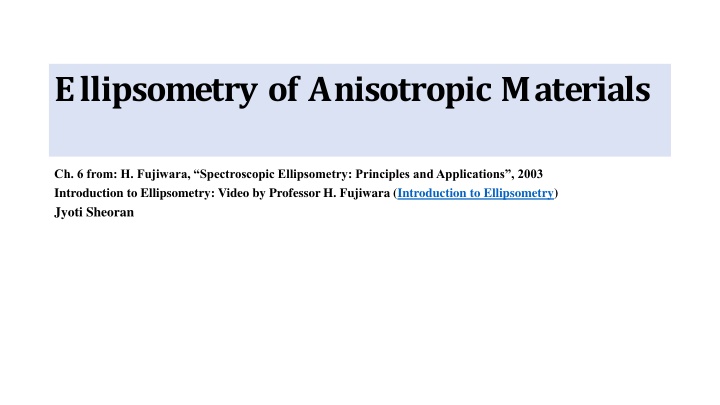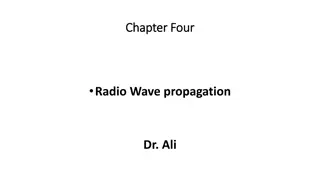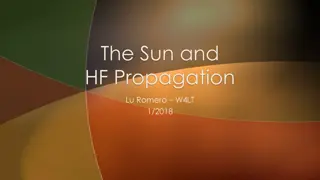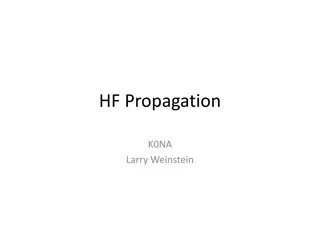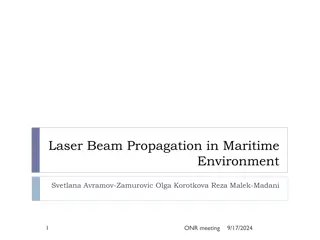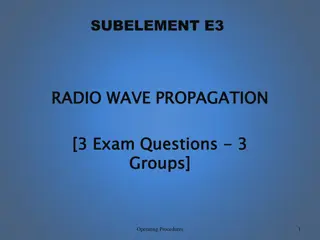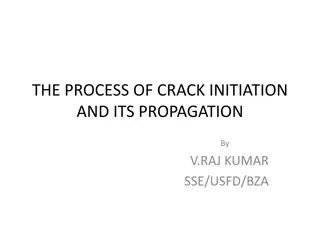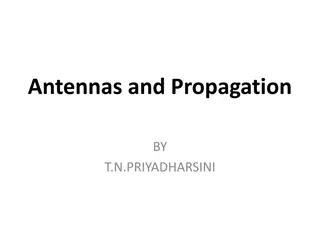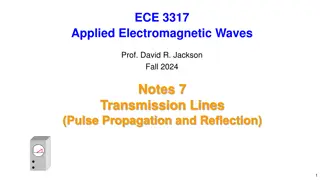Light Propagation in Anisotropic Media
Light propagation behaves differently in anisotropic materials compared to isotropic ones, with variations depending on the material's principle directions and optical axes. This phenomenon is explored in Chapter 6 of "Spectroscopic Ellipsometry: Principles and Applications" by H. Fujiwara (2003), covering uniaxial and biaxial materials, ordinary and extraordinary rays, positive and negative uniaxial materials, as well as the impact of absorption coefficients on the intensity of light propagation.
Download Presentation

Please find below an Image/Link to download the presentation.
The content on the website is provided AS IS for your information and personal use only. It may not be sold, licensed, or shared on other websites without obtaining consent from the author.If you encounter any issues during the download, it is possible that the publisher has removed the file from their server.
You are allowed to download the files provided on this website for personal or commercial use, subject to the condition that they are used lawfully. All files are the property of their respective owners.
The content on the website is provided AS IS for your information and personal use only. It may not be sold, licensed, or shared on other websites without obtaining consent from the author.
E N D
Presentation Transcript
Ellipsometry of Anisotropic Materials Ch. 6 from: H. Fujiwara, Spectroscopic Ellipsometry: Principles and Applications , 2003 Introduction to Ellipsometry: Video by Professor H. Fujiwara (Introduction to Ellipsometry) Jyoti Sheoran
Light propagation in anisotropic media Anisotropy implies that light incident onto the different principle directions of the material (x, y, z) behaves differently depending upon the direction. Isotropic materials: Anisotropic materials: *Chapter 6: H. Fujiwara, Spectroscopic Ellipsometry: Principles and Applications , 2003
Light propagation in anisotropic media Uniaxial material: One Optic axis Biaxial material: Two Optic axis
Light propagation in anisotropic media Introduction to Ellipsometry: Video by Professor H. Fujiwara (Introduction to Ellipsometry)
Light propagation in anisotropic media Change in the propagation of light with n and k Here we see that gives an exponential decay. Since intensity is proportional to the square of the electric field, the intensity will depend on the depth of the material: Fig : Propagation of electromagnetic waves in (a) transparent medium (k=0) and (b) A light absorbing medium and thus the absorption coefficient is = 4 / 0 *Chapter 1: H. Fujiwara, Spectroscopic Ellipsometry: Principles and Applications , 2003
Light propagation in anisotropic media Uniaxial materials: Biaxial materials: *Chapter 6: H. Fujiwara, Spectroscopic Ellipsometry: Principles and Applications , 2003
Light propagation in anisotropic media Uniaxial materials: Ordinary ray oscillating direction is perpendicular to the optical axis Extraordinary ray - oscillating direction has a component parallel to the optical axis Positive uniaxial materials: Negative uniaxial materials: 0 0 a) Positive uniaxial b) Negative uniaxial *Chapter 6: H. Fujiwara, Spectroscopic Ellipsometry: Principles and Applications , 2003
Light propagation in anisotropic media *Chapter 6: H. Fujiwara, Spectroscopic Ellipsometry: Principles and Applications , 2003 Wavelets radiated toward the directions of a, b, and c indicated in (a) (c) ordinary ray and (d) (f) extraordinary ray Propagation vector: (perpendicular to the tangent plane of the ellipsoid) Poynting vector:
Light propagation in anisotropic media *Class notes: V Gopalan, Crystal Anisotropy *http://nicadd.niu.edu/~piot/phys_630/Lesson14.pdf
Index ellipsoid Electric displacement: Dx = xxEx + xyEy + xzEz Dy = yxEx + yyEy + yzEz Dz = zxEx + zyEy + zzEz dielectric tensor For transparent crystals (kx = ky = kz = 0), yx = xy , xz = zx , yz = zy . The energy density of the electric field: By setting we obtain: Since Index ellipsoid (transformed to its principal axes) , the semi axes of this ellipsoid correspond to the refractive indices along x, y, and z axes. x, y, and z axes - principal axes; x, y, and z, - principal dielectric constants; nx, ny, and nz, - principal indices of refraction *Chapter 6: H. Fujiwara, Spectroscopic Ellipsometry: Principles and Applications , 2003
Index ellipsoid Isotropic Cubic Tetragonal Uniaxial orthorhombic Biaxial *Class notes: V Gopalan, Crystal Anisotropy
Index ellipsoid Figure shows the index ellipsoids of (a) isotropic material nx = ny = nz (b) uniaxial material nx = ny < nz and (c) biaxial material nx < ny < nz The light waves travel inside the anisotropic medium in the direction of K. From the cross-section of the index ellipsoid, the refractive indices for the electric displacements D1 and D2 are given by n1 and n2, respectively. *Chapter 6: H. Fujiwara, Spectroscopic Ellipsometry: Principles and Applications , 2003
Dielectric tensor When principal axes of index ellipsoid coincide with the (x, y, z) coordinates: If not: Transformation of (x, y) coordinates into (x , y ) by coordinate rotation (in 2D) ; *Chapter 6: H. Fujiwara, Spectroscopic Ellipsometry: Principles and Applications , 2003
In 3D, the transformation of the coordinate system from (x, y, z) to ( , , ) using the Euler angles ( E, E, E): Step 2: Step 3: *Chapter 6: H. Fujiwara, Spectroscopic Ellipsometry: Principles and Applications , 2003
Dielectric tensor Combining all three rotations the full coordinate transformation is expressed by: *Chapter 6: H. Fujiwara, Spectroscopic Ellipsometry: Principles and Applications , 2003
Dielectric tensor Inverse transformation matrix: B = A-1 = AT (aij= aTji) The rotation of a tensor Q using a rotation matrix M is expressed by MQM-1. Thus, the dielectric tensor in the (x, y, z) coordinate system: This tensor is symmetric: ij- ji *Chapter 6: H. Fujiwara, Spectroscopic Ellipsometry: Principles and Applications , 2003
Jones matrix for polarized monochromatic wave The polarization state of light is represented by superimposing two waves oscillating parallel to the x and y axes. The Jones vector is defined by the electric field vectors in the x and y directions.
Jones Vectors Def. of J ones Vector: where: exp(i x) = cos( x) + i sin( x) general case of an ellipse:
Jones Vectors Matrices representing the transformations which occur when polarized light passes through a certain optical element Used to mathematically transform the Jones Vectors of polarization states
Jones matrix of anisotropic samples Lightwave transmitting through a retarder ( /4 plate). The optical axis of the retarder is rotated by 45o relative to the Ex axis Jones matrix for the compensator (retarder): = /2. The off-diagonal elements of the Jones matrix are not zero. For Eix = 0, Eiy = 1, C = 45o, and = 90o
Summary Difference between Isotropic and Anisotropic medium Uniaxial, Biaxial medium Light propagation in an Anisotropic medium Index Ellipsoid Dielectric Tensor Jones matrix
